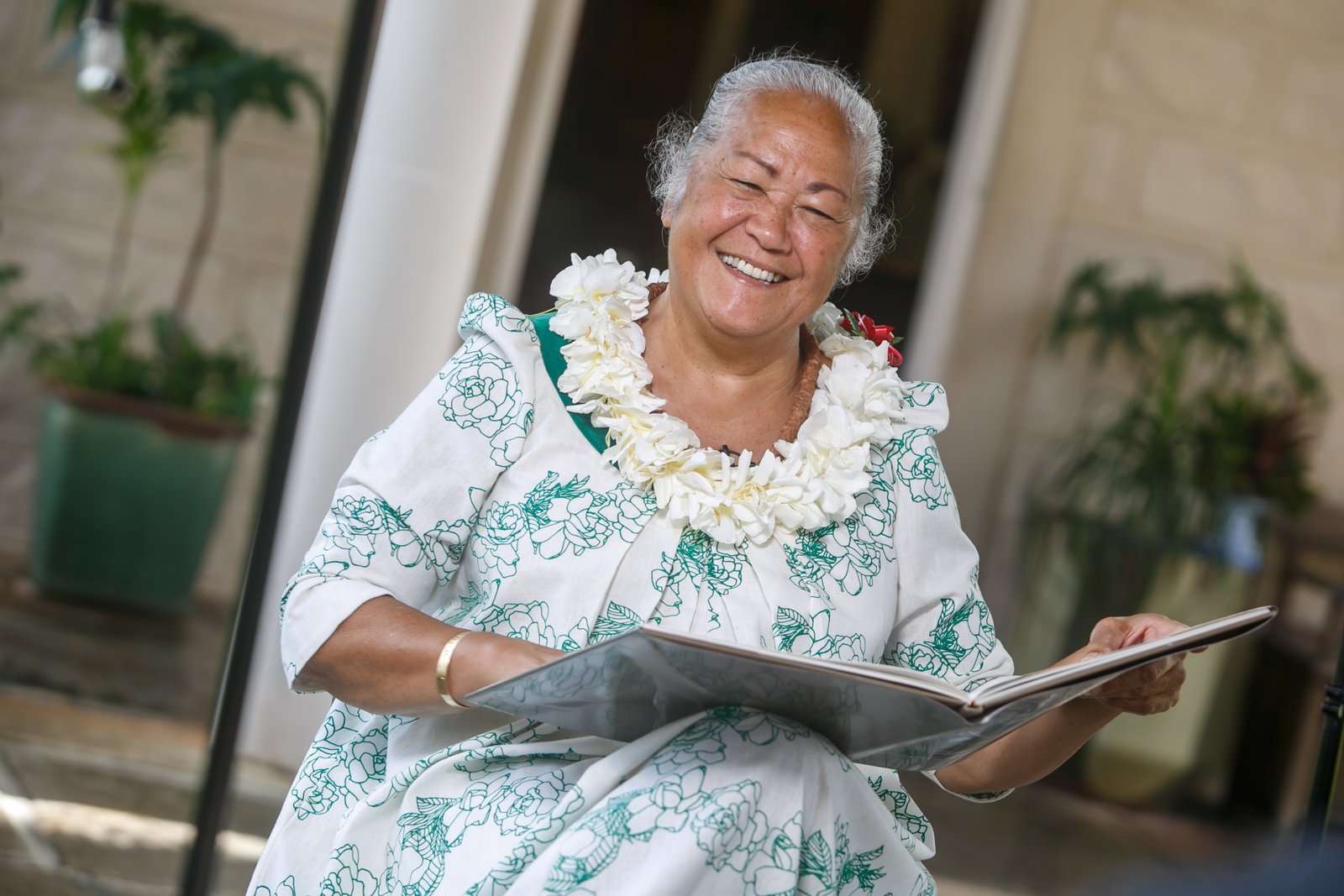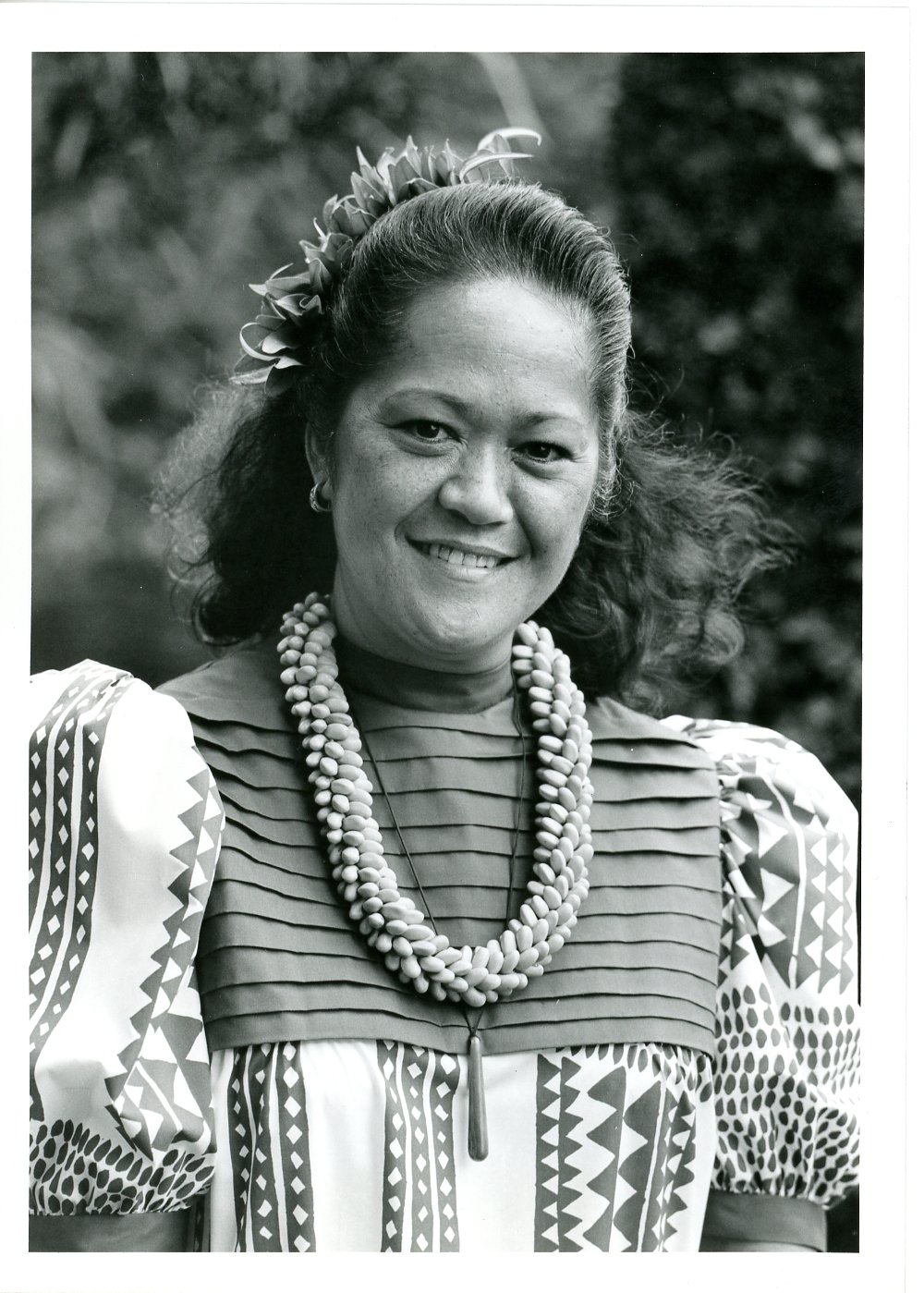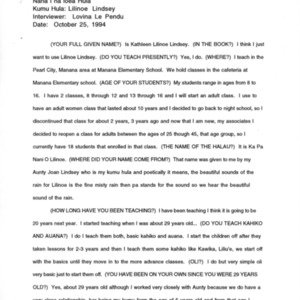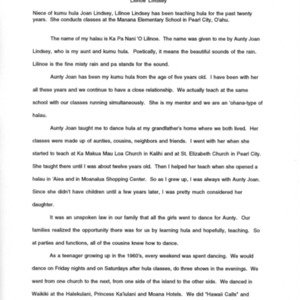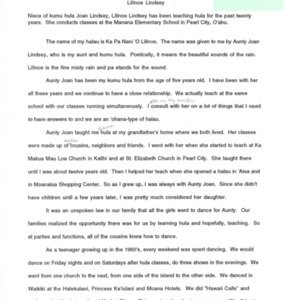Lilinoe Lindsey
Title
Lilinoe Lindsey
Subject
Nā Kumu Hula Lilinoe Lindsey text from Nānā I Na Loea Hula Vol Two Page 66
Description
Lilinoe Lindsey is the niece of kumu hula Joan Lindsey and currently teaches hula at the Manana Elementary School in Pearl City, 0‘ahu.
It was an unspoken law in our family that all the girls went to dance for Aunty. Our families realized the opportunity there was for us by learning hula and hopefully, teaching.
So at parties and functions all of the cousins knew how to dance.
Aunty Joan Lindsey has been my kumu hula from the age of five- years-old. 1 have been with her all these years and we continue to have a close relationship. We actually teach at the same school with our classes running simultaneously. She is my mentor and we are an ‘ohana- type of halau.
Aunty Joan taught me to dance hula at my grandfather’s home where we both lived. Her classes were made up of aunties, cousins, neighbors, and friends. 1 went with her when she started to teach at ka Makua Mau Loa Church in Kalihi and at St. Elizabeth Church in Pearl City. She taught there until I was about twelve-years-old. Then I helped her teach when she opened a halau in ‘Aiea and in Moanalua Shopping Center. So as I grew up, I was always with Aunty Joan. Since she didn’t have children until a few years later, I was pretty much considered her daughter.
I was twenty-one when we had an ‘uniki at the Neal Blaisdell Center. We all had to do our kahiko and our "a liana as part of the ‘uniki ritual. Each class had to make their skirts differently and all who ‘uniki were required to have taken hula for at least ten years.
As a teenager growing up in the Sixties, every weekend was spent dancing. We would dance on Friday nights, and on Saturdays after hula classes do three shows in the evenings. We went from one church to the next, from one side of the island to the other side. We danced in Waikiki at the Halekulani, Princess Ka'iulani, and Moana Hotels. We did “Hawai‘i Calls” and performed at the International Market Place. This went on for about seven years. You never realize how much you have learned and gained from being a hula dancer until after growing up.
I have Aunty’s style of hula which is a basic style with flat- foot and very simple. We are very smooth and graceful and we tend to spend a lot of time developing the dancer’s gracefulness and smooth transition from one motion to the next. It is similar to tai chi where your movement is a flowing style that never stops and one motion leads into the next without much distinction. The kaholo vamp step requires that the heel of the foot be turned forward on the fourth beat. Thus forming a ninety degree angle with the toe of one foot almost meeting the heel of the other foot. The ‘uwehe step is done with a quick forward thrust of the knees and not to the sides. These are a few slight differences in Aunty’s style and execution compared to other kumu.
I enjoy kahiko more than I do ‘auana. I always enjoy the rhythm, the tempo, and the sound of the ipu and the pahu. It brings me into the center of hula. I am learning the culture while dancing kahiko. For some reason just the movement itself gives me the feeling of what our culture is all about.
The name of my halau is Hālau Ka Pā Nani 'O Lilinoe. The name was given to me by Aunty Joan. Poetically it means, “the beautiful sounds of the rain.” Lilinoe is the fine misty rain and pa stands for the sound.
I think it’s important to relate to each child individually rather than just treating them as a mass group. I want each child to know that they are very important to me and their development is important to me. I try to do my very best to help them and I always pray that I will be able to recognize their needs.
Aunty has been a great influence in my life. As I grew up, she advised me on what was best for me. I took her suggestions under deep consideration and made my decisions based on what she felt would help me throughout my life. We still go everywhere together. We do shows together and we pretty much help each other out. She influenced me to the point that I knew that hula would always be a big part of my life. And it has.
It was an unspoken law in our family that all the girls went to dance for Aunty. Our families realized the opportunity there was for us by learning hula and hopefully, teaching.
So at parties and functions all of the cousins knew how to dance.
Aunty Joan Lindsey has been my kumu hula from the age of five- years-old. 1 have been with her all these years and we continue to have a close relationship. We actually teach at the same school with our classes running simultaneously. She is my mentor and we are an ‘ohana- type of halau.
Aunty Joan taught me to dance hula at my grandfather’s home where we both lived. Her classes were made up of aunties, cousins, neighbors, and friends. 1 went with her when she started to teach at ka Makua Mau Loa Church in Kalihi and at St. Elizabeth Church in Pearl City. She taught there until I was about twelve-years-old. Then I helped her teach when she opened a halau in ‘Aiea and in Moanalua Shopping Center. So as I grew up, I was always with Aunty Joan. Since she didn’t have children until a few years later, I was pretty much considered her daughter.
I was twenty-one when we had an ‘uniki at the Neal Blaisdell Center. We all had to do our kahiko and our "a liana as part of the ‘uniki ritual. Each class had to make their skirts differently and all who ‘uniki were required to have taken hula for at least ten years.
As a teenager growing up in the Sixties, every weekend was spent dancing. We would dance on Friday nights, and on Saturdays after hula classes do three shows in the evenings. We went from one church to the next, from one side of the island to the other side. We danced in Waikiki at the Halekulani, Princess Ka'iulani, and Moana Hotels. We did “Hawai‘i Calls” and performed at the International Market Place. This went on for about seven years. You never realize how much you have learned and gained from being a hula dancer until after growing up.
I have Aunty’s style of hula which is a basic style with flat- foot and very simple. We are very smooth and graceful and we tend to spend a lot of time developing the dancer’s gracefulness and smooth transition from one motion to the next. It is similar to tai chi where your movement is a flowing style that never stops and one motion leads into the next without much distinction. The kaholo vamp step requires that the heel of the foot be turned forward on the fourth beat. Thus forming a ninety degree angle with the toe of one foot almost meeting the heel of the other foot. The ‘uwehe step is done with a quick forward thrust of the knees and not to the sides. These are a few slight differences in Aunty’s style and execution compared to other kumu.
I enjoy kahiko more than I do ‘auana. I always enjoy the rhythm, the tempo, and the sound of the ipu and the pahu. It brings me into the center of hula. I am learning the culture while dancing kahiko. For some reason just the movement itself gives me the feeling of what our culture is all about.
The name of my halau is Hālau Ka Pā Nani 'O Lilinoe. The name was given to me by Aunty Joan. Poetically it means, “the beautiful sounds of the rain.” Lilinoe is the fine misty rain and pa stands for the sound.
I think it’s important to relate to each child individually rather than just treating them as a mass group. I want each child to know that they are very important to me and their development is important to me. I try to do my very best to help them and I always pray that I will be able to recognize their needs.
Aunty has been a great influence in my life. As I grew up, she advised me on what was best for me. I took her suggestions under deep consideration and made my decisions based on what she felt would help me throughout my life. We still go everywhere together. We do shows together and we pretty much help each other out. She influenced me to the point that I knew that hula would always be a big part of my life. And it has.
Birth Date
November 21, 1946
Birthplace
Honolulu, Hawai'i
Hālau
Hālau Ka Pā Nani 'O Lilinoe
Hula Training/
Competitions
Joan S Lindsey 1951-1967
George Na'ope 1988
John Ka'imikaua 1991
Edith McKenzie 1991
Kawika Makanani 1982
Pilahi Paki 1986
Ke'ala Kwan 1993-1994
Edith McKenzie 1994
Leialoha Perkins 1992
Keoni Nunes 1992
HULA COMPETITIONS
Queen Lili'uokalani Keiki Hula Competitions 1982 - Present
King David Kalakaua Keiki Hula - Kona, Hawaii 1986, 1991
King Kamehameaha Hula 1986
Prince Lot Festival 1994
Moanike'ala 'Auana Keiki festival 1993-1994
Nā Hula o Hawai'i Keiki Komedy Hula Festival 1994
George Na'ope 1988
John Ka'imikaua 1991
Edith McKenzie 1991
Kawika Makanani 1982
Pilahi Paki 1986
Ke'ala Kwan 1993-1994
Edith McKenzie 1994
Leialoha Perkins 1992
Keoni Nunes 1992
HULA COMPETITIONS
Queen Lili'uokalani Keiki Hula Competitions 1982 - Present
King David Kalakaua Keiki Hula - Kona, Hawaii 1986, 1991
King Kamehameaha Hula 1986
Prince Lot Festival 1994
Moanike'ala 'Auana Keiki festival 1993-1994
Nā Hula o Hawai'i Keiki Komedy Hula Festival 1994
Citation
“Lilinoe Lindsey,” Nā Kumu Hula Archive, accessed June 29, 2025, https://nakumuhula.org/archive/items/show/21.

